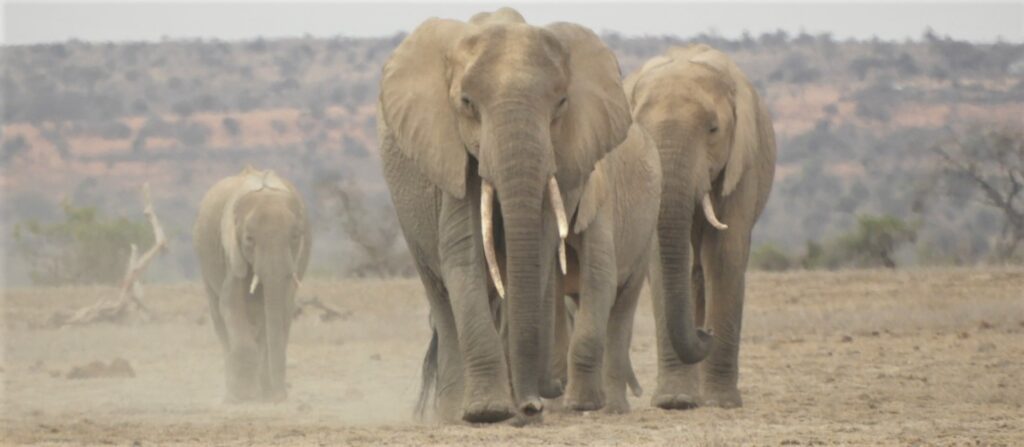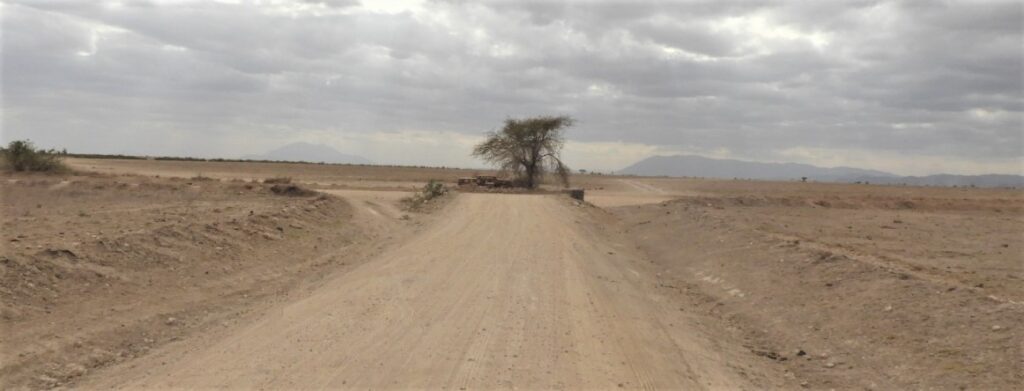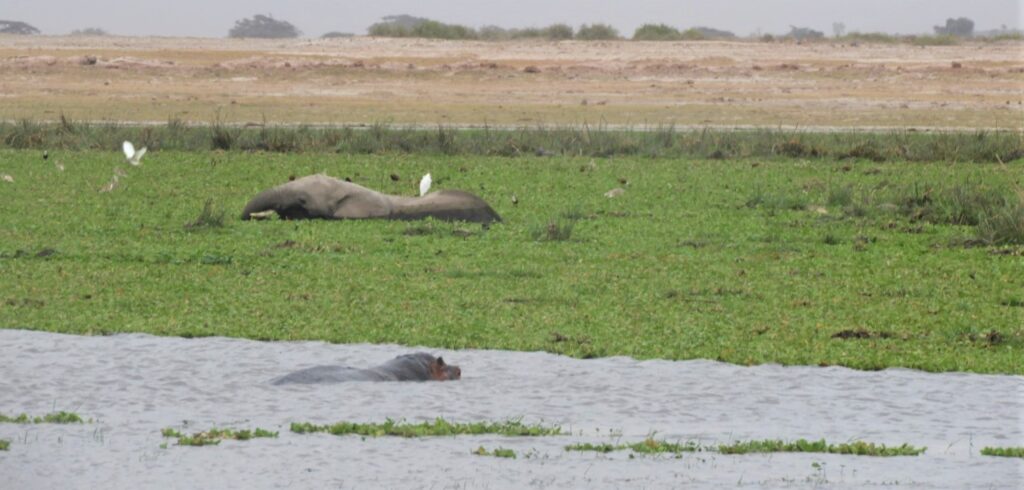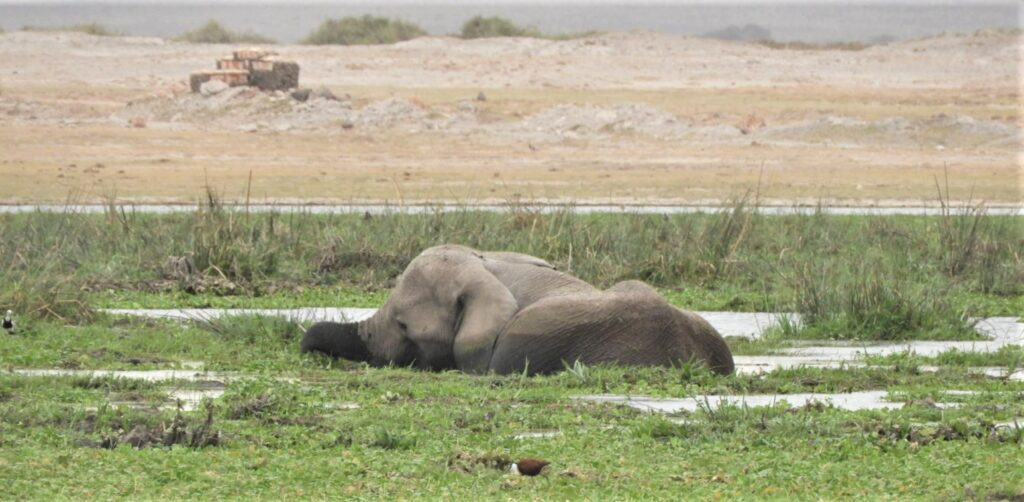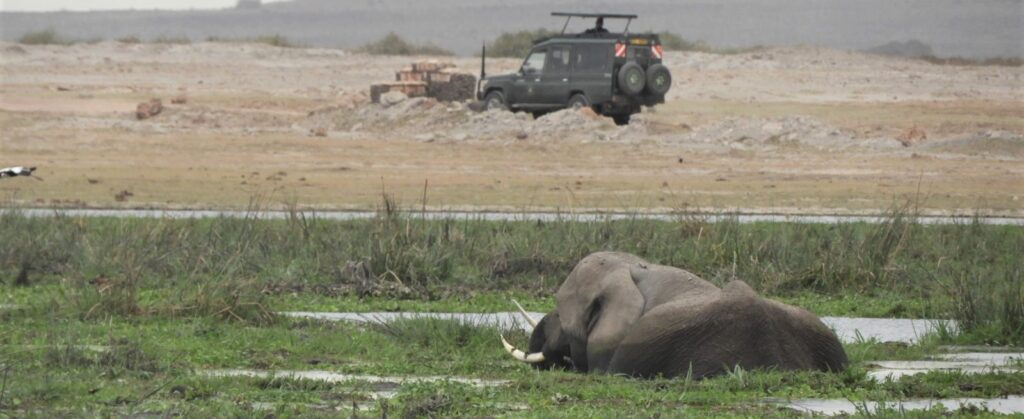» posted on Saturday, September 17th, 2022 by Linda Lou Burton
A Strange Land
Linda Lou Burton posting from Amboseli National Park, Kenya– “An elephant can eat 600 pounds of food a day,” Amos told us. We’d just passed a splintered tree, damaged by 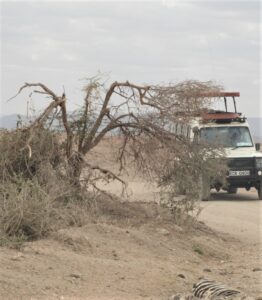 elephants, we were told, as Amos turned the 4×4 to go further into the park. Another zebra carcass there; our companion 4×4 was turning too. Amos explained more about Amboseli as we continued on the drive; a place famous for its elephants. I remembered the sign plastered on our plane today “Hands Off Our Elephants.” “Are the elephants dying of thirst too?” I asked. “No” was his answer; “that sign refers to poachers. But a serious crackdown on poaching has greatly reduced the numbers killed by human hands. So the elephant population is increasing here. More elephants means the food supply is more in demand, and now, due to the drought, that is fast being depleted. And since the snow cap on the mountain is disappearing, the water supply is disappearing too.” Just then, a rumbling sound; elephants, moving fast. We stopped to watch; the dust, the thundering intensity. Serious in purpose, mothers and children, looking for food, for daily sustenance. They passed us by, were gone, no need to stop, nothing here.
elephants, we were told, as Amos turned the 4×4 to go further into the park. Another zebra carcass there; our companion 4×4 was turning too. Amos explained more about Amboseli as we continued on the drive; a place famous for its elephants. I remembered the sign plastered on our plane today “Hands Off Our Elephants.” “Are the elephants dying of thirst too?” I asked. “No” was his answer; “that sign refers to poachers. But a serious crackdown on poaching has greatly reduced the numbers killed by human hands. So the elephant population is increasing here. More elephants means the food supply is more in demand, and now, due to the drought, that is fast being depleted. And since the snow cap on the mountain is disappearing, the water supply is disappearing too.” Just then, a rumbling sound; elephants, moving fast. We stopped to watch; the dust, the thundering intensity. Serious in purpose, mothers and children, looking for food, for daily sustenance. They passed us by, were gone, no need to stop, nothing here. 
The road ahead stretched long, the dust as far as I could see. “Where is water?” I asked, wondering about the mountain top, the melting ice. Wondering about the dust surrounding me. “The swamps,” was the reply, “the fresh-water swamps, created from the springs. The snow melt sinks into the ground on the mountain, emerges on the plain as swamps.” I’d only known Amos an hour. He was thoughtful, and intelligent, I could tell. But could we believe this man who was a stranger to us, here in this strange land? I pressed for more. “Swamps in all this dust? How can that be?” “You’ll see,” he said, and suddenly, there they were. Water holes, filled with marshy greens, and hippos, and birds. And elephants, eyeball deep in water. Just feet away, more dust. Like crazy mirrors in an amusement park, distorting everything, illusion, or reality? The day would get stranger still, we were soon to see. 
Factoids about Amboseli: The word “Amboseli” is an English corruption of the Maasai Maa word “Empusel” meaning “salty dust.” The area is classified as semi-arid savanna. Melting snows and rainfall on Mt Kilimanjaro percolate through the porous soil into an extensive subterranean aquifer reemerging in the basin as permanent swamps. Two large swamps, Longinye and Enkongo Narok, transect the basin and numerous smaller swamps surface in the central and western parts of the park, home to a myriad of species of animals. During the long rains between March and April, the dry plain can become a shallow lake, filled with wading birds (there are 400 species here alone).
Next post: The strange shallow lake and the wading birds.
Amboseli National Park https://amboseli.com/

